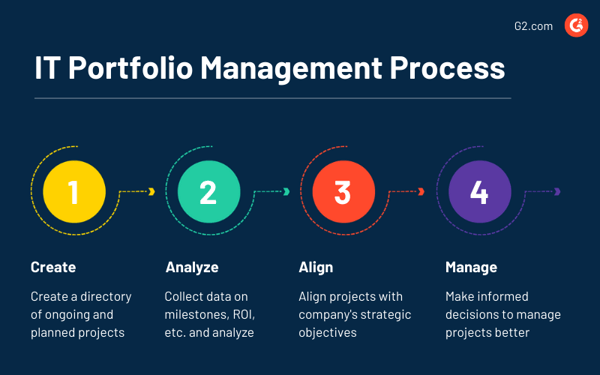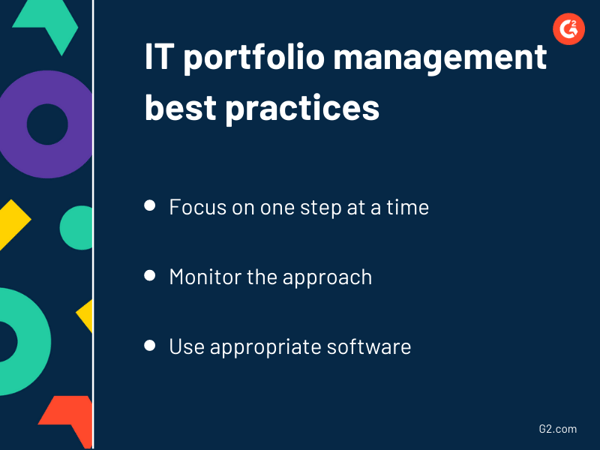September 30, 2020
 by Sagar Joshi / September 30, 2020
by Sagar Joshi / September 30, 2020

Managing a multitude of IT projects is tricky.
You need to take care of many activities, assets, and resources for handling your projects and driving results. But when there is a lack of standardization, managing your IT portfolio might turn out to be even more complicated.
You should have a proper process in place to maintain frictionless progress of projects. IT portfolio management is one such process that empowers you to organize and manage your projects and initiatives, enabling you to gain sufficient data for strategic decision-making.
You can do so manually on spreadsheets for a handful of projects. But it's advisable to use technology like IT service management software, portfolio management software, and more, when you are doing it on a larger scale.
IT portfolio management is a systematic approach of planning and organizing projects, activities, initiatives, and investments in a company's IT department, ensuring growth, cost reduction, and business continuity. It enables you to manage your resources and infrastructure and govern your IT investments objectively.
Earlier, these were taken care of in an informal way, but with IT portfolio management, you obtain a better and clearer picture of your financials allied with the IT department. Simply put, the process helps you in tracking and managing your IT budgets at a granular level.
Since its inception, IT portfolio management had a project-centric bias, but now it has evolved. It's not just the usual operational tracking anymore;, it has expanded its scope to include steady-state project entries, application management, and more.
You have a top-down project planning approach in the process where the stakeholders take part in decision-making and share directives among the rest of the teams. Here, the unifying goal of IT portfolio management is to gain complete visibility over the business' needs from the IT department and better forecast the demands that may arise in the foreseeable future.
IT portfolio management is a step-by-step process covering all projects and application services, which are a part of overall operations.

Let's dive deeper into understanding the complete process of IT portfolio management.
First, you need to evaluate all projects and activities, including those outlined in the future. This includes creating inventories of all IT investments, identifying the project's present stage in the lifecycle, evaluating them, and driving the business toward its strategic objectives and goals.
Check if the projects and future initiatives are aligned with the business' goals, and if not, the most functional areas you should address to converge it in the direction of your company's path. Next, create a business strategy to streamline the operational processes and better achieve those targets. It’s best to build an implementation team with members from the IT department to execute the strategy and the finance department to keep a closer look on the investments. Sometimes the implementation team may have members from the people's team to manage resources better.
The implementation team will have a governing authority to oversee its operations. This authority can be an individual or a group of professionals from the company's senior leadership to perform what-if analysis, adjusting key constraints and other parameters of the IT portfolio. They measure the impact of alternative investment options and decide the optimal allocation of investments into different categories.
While analyzing, evaluate the strengths and weaknesses of your projects objectively. This entails collecting data regarding your project's milestones, reporting schedule, the potential return on investment (ROI), and resource allocation.
You should give a proper structure to the portfolio, which means establishing metrics to track progress, organizing, and classifying the weightage of activities and processes. Identify any duplication or if some existing projects might not provide substantial efficiency when executed parallelly.
Evaluating risks is a part of this step, where you should set standard criteria with threshold levels, and weigh the anticipated benefits of the IT project/activity against the financial and technical success of the overall portfolio. Establish a screening mechanism to assess the technical conditions, business value, and risk. It’s essential to assure IT's success in enhancing business and mission performance. In the analysis stage, gaps in requirements, standards, stakeholder analysis, enterprise architecture view, and a comprehensive catalog of IT assets should be made available so that you can map IT investments to these areas quickly.
Ensuring straightforward communication and brainstorming is a pivotal part here; after all, you need to discuss all key variables thoroughly.
Performing an alignment analysis will help you observe the critical projects and whether your critical resources are working on them. Carve out teams' guidelines to ensure the projects align with the company's strategic objectives.
Your guidelines should fundamentally include the degree of strategic fit between the portfolio and the company. You need to find a balance between short-term goals, long-term goals, and periodic innovations. Then, showcase the number and nature of the projects aligned to different strategic goals in such a way that they add economic value and deliver expected results. You should also place measures to evaluate associated risks, not only in financial portfolio but also the challenges that may arise in the schedule, resources, scope, or technology.
In the IT portfolio management process, IT investments are tracked and monitored. You have balanced scorecards, KPIs, service level agreements (SLA), and other metrics to measure IT investments' health. But when these metrics defeat the threshold levels, it triggers changes in the IT portfolio. As the investments are re-evaluated here, the business case should be updated in alignment with the company's objectives.
In managing your IT portfolio, make essential investment decisions of reallocating budgets, resources, prioritization of projects, and more based on parameters and variables you discovered during the previous stages of the IT portfolio management process.
In this step, focus on risk management, resource management, and change management. During the complete process, collaboration is paramount to make strategic decisions and meet internal requirements.
There may be instances where you don’t get your IT project portfolio management process right on the first try. Test and adapt in real time as the needs of IT organizations are different. It’s best if you always take on feedback. Initially, start with a few stakeholders, take their suggestions, and adopt an agile methodology for managing information technology portfolios. IT project portfolio management can be a bit complex initially, but once you scale your expertise on it, you will be able to guide your IT department better.
The value is demonstrated by assessing execution, evaluating program execution, and measuring the IT portfolio's actual performance.
IT portfolio management helps you build a strategic perspective toward managing the plethora of activities in planned and ongoing projects. Let’s discuss the best practices to start with the process and accelerate your business toward strategic growth.

If you’ve recently taken on an IT portfolio manager's responsibilities, it's important that you take one step at a time, in a phased approach. You will come across various activities that need to be managed, but on ground zero, focus on implementing the strategy on one business unit instead of the entire department.
It will help you identify flaws in the process before expanding the implementation company-wide, and it’s important to not rush into it.. To take your IT portfolio management from zero to 100, follow one step at a time, test it on a small scale, and adapt.
The IT portfolio management process varies across companies. It's not a one-size-fits-all approach. You need to maintain your agility and optimize based on the results that your approach delivers. So it's crucial to keep track of your results all the time.
You can measure the performance of your previous projects and identify specific changes that delivered expected results. When you evaluate your performance in long-term projects objectively, you can easily find gaps between what your project was expected to deliver in the initial stage and what it actually delivered upon completion. This will enable you to optimize your planning and managing approach better.
As an IT portfolio manager, tracking and reporting on a wide variety of activities is your daily cup of tea. But when the projects increase in the IT portfolio, so does the hassle in managing them manually. You need IT portfolio management software to strengthen your muscle in managing them. IT portfolio management tools help you organize resources and activities across multiple IT portfolios and maximize revenue and ROI.
As an IT portfolio manager, you are responsible for successfully implementing IT strategy in an organization. The role usually revolves around IT management and working with different financial algorithms and models to converge IT operations toward the organization's strategic goals and objectives.
You would keep a high-level overview of everything within a portfolio and develop management standards to ensure better functioning and coordination in the IT department.
IT portfolio managers can be a part of the Project Management Office (PMO), where they manage portfolios and set business processes and standards for the department to follow. You can also set methodologies such as Agile or Scrum for managing IT portfolios in a better way.
There are numerous benefits of the IT portfolio management for a business. Here are a few specifically.
With IT portfolio management, you reduce your expenses by cutting out the redundant projects and efficiently utilizing resources and assets. As you gather data and information from multiple tasks in a single directory, you can easily visualize the repetitive activities going on, and you can shred them to save costs.
As you have overseen the progress and performance of projects in your pipeline, you can make data-driven decisions to forecast your department's needs and better plan your IT projects in the foreseeable future. It helps you master the top-down approach of project management and supports your decisions with data as an asset.
IT portfolio management helps you gain clarity over different projects and align them better with your business objectives and goals. You establish particular targets and milestones in the process that allows you to identify how its completion adds value to the business goal and motivates you to work productively without the clutter.
There are a multitude of unforeseen factors that may hinder the progress of a project. The IT portfolio management process equips professionals to manage projects in diverse situations with a centralized database of all activities and promotes agility and adaptability to ensure timely deliverables.
Managing an IT portfolio requires cooperation and collaboration between different teams and stakeholders. You need to manage your budget, risk, and resources efficiently to maintain a successful IT portfolio. But there are a few challenges that could come your way.
Some teams might show resistance to adopt a new task or tool, even if it makes the work easier. The reason could be a steep learning curve of the latest software or complications in introducing a new activity.
It's essential to provide proper training before introducing new technology while ensuring that the entire team is on the same page. Give them a sneak peek into how the new task or tool can become an asset to the business. You need to show them the value and efficiency it can bring to your IT portfolio management process.
You have visibility across multiple IT projects in various places, but it may not be in the same format. It's primarily due to a lack of standardization in capturing and reporting data by professionals or software due to the team's varied needs. Comparing data of such projects might be problematic as you wouldn't be able to evaluate them objectively.
You can solve it by implementing an IT portfolio management tool, which can bring data together in a uniform format, enabling you to follow and examine. It also can allow you to ensure efficient reporting and save time by using automation.
The major challenge in IT portfolio management is managing resources. You need to ensure that the best of your people are working on the right projects at the right time. Sometimes, delays may happen as the information is collected from IT, finance, and HR teams to align resources strategically, so it's essential to have a centralized information system to pull data required for proper resource allocation.
With an impeccable IT portfolio management process, you will be able to strategically use your resources and assets to produce exemplary results in projects. Start by implementing the process today and ensure proper alignment of your IT strategy toward your business objective and drive value.
Learn more about how to manage your SaaS spend and save even more on IT costs.
Sagar Joshi is a former content marketing specialist at G2 in India. He is an engineer with a keen interest in data analytics and cybersecurity. He writes about topics related to them. You can find him reading books, learning a new language, or playing pool in his free time.
A portfolio is a collection of your best work, put forth in the hopes of making a positive...
 by Grace Pinegar
by Grace Pinegar
Managing properties is tough. I get it.
 by Soundarya Jayaraman
by Soundarya Jayaraman
Every day, strategic decisions must be made to monitor, assess, protect, and optimize your...
 by Dimitri Raziev
by Dimitri Raziev
A portfolio is a collection of your best work, put forth in the hopes of making a positive...
 by Grace Pinegar
by Grace Pinegar
Managing properties is tough. I get it.
 by Soundarya Jayaraman
by Soundarya Jayaraman


